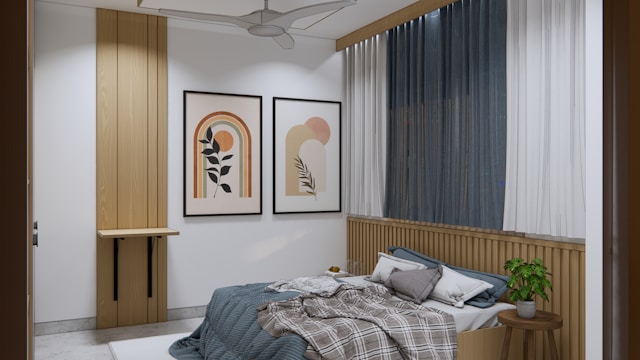Choosing the right ceiling fan size for your bedroom isn’t just about comfort, it’s about achieving the perfect balance between air circulation, energy efficiency, and aesthetics. The wrong size fan can make a room feel drafty or underpowered, while the right one can improve sleep quality, reduce electricity costs, and enhance the look of your space.
In this 2025 guide, we’ll explore how to choose the perfect fan size for your bedroom based on room dimensions, ceiling height, and design preferences. You’ll also find expert recommendations, comparisons, and visual ideas to help you make a confident choice.
Why Fan Size Matters More Than You Think
Fan size directly impacts how well air circulates in your bedroom. A fan that’s too small won’t move enough air to keep you cool, while one that’s too large can create excessive airflow or noise.
According to the American Lighting Association (ALA), proper fan sizing can improve air movement efficiency by up to 40%, reducing your reliance on air conditioning and saving on energy costs.
In bedrooms, comfort depends on balanced air distribution you want a gentle, consistent breeze, not a turbulent draft. Choosing the right size ensures your fan delivers quiet, efficient airflow even on lower speed settings.
Ceiling Fan Size Chart for Bedrooms (2025 Update)
Here’s an updated chart showing the ideal fan blade span (diameter) based on bedroom size:
Bedroom Size (sq. ft.) |
Recommended Fan Blade Span |
Typical Fan Size Category |
|---|---|---|
Up to 75 sq. ft. |
29″ – 36″ |
Small Bedroom / Kids’ Room |
76 – 144 sq. ft. |
36″ – 42″ |
Medium Bedroom |
145 – 225 sq. ft. |
44″ – 50″ |
Standard Bedroom |
226 – 400 sq. ft. |
50″ – 60″ |
Master Bedroom / Large Room |
Over 400 sq. ft. |
60″ – 72″+ |
Oversized Bedroom / Suite |
How to Measure Your Bedroom for the Right Fan Size
-
Measure Room Dimensions – Multiply the length and width of your bedroom to get the total square footage.
Example: 12 ft × 14 ft = 168 sq. ft. -
Match to Chart Above – A 168 sq. ft. bedroom fits best with a 44–50 inch fan.
-
Consider Ceiling Height:
-
For standard 8 ft ceilings, use a low-profile or flush-mount fan.
-
For 9 ft or higher ceilings, use a downrod to position the fan 8–9 ft above the floor.
-
For vaulted ceilings, use an angled mount or extension rod for proper airflow.
-
Airflow (CFM) and Energy Efficiency
Aside from size, the airflow rating (CFM Cubic Feet per Minute) determines how much air the fan moves.
-
Small bedrooms (up to 144 sq. ft.): 1,500–3,000 CFM
-
Medium bedrooms (145–225 sq. ft.): 2,500–4,500 CFM
-
Large bedrooms (226–400 sq. ft.): 4,000–6,500 CFM
Modern 2025 ENERGY STAR–rated ceiling fans can save up to 20% more energy compared to older models. They also come with DC motors, which are quieter and use 70% less power than traditional AC motors.
Matching Fan Design to Bedroom Style
A ceiling fan isn’t just functional it’s also a design statement. Here’s how to choose a fan that complements your bedroom aesthetics:
Bedroom Style |
Recommended Fan Design |
Example Finish |
|---|---|---|
Modern / Minimalist |
Sleek, 3-blade DC fans |
Matte black or white |
Rustic / Farmhouse |
Woodgrain or barnwood finish |
Weathered oak |
Luxury / Contemporary |
Smart fans with LED lights |
Brushed nickel |
Coastal / Boho |
Rattan or bamboo blades |
Natural wood |
2025 Trend Insight:
According to Houzz’s 2025 Interior Trends Report, smart fans with app or voice control are increasingly popular in modern bedrooms. They allow automated speed adjustments based on room temperature, improving comfort and efficiency.
Ceiling Fan vs. Tower Fan for Bedrooms
If your bedroom setup doesn’t allow ceiling installation, you might consider an alternative like a tower fan. Here’s how they compare:
Feature |
Ceiling Fan |
Tower Fan |
|---|---|---|
Air Coverage |
Whole-room circulation |
Focused, directional airflow |
Noise Level |
Low (especially DC models) |
Moderate, depending on motor |
Installation |
Permanent (ceiling mount) |
Portable and plug-in |
Energy Use |
Lower over time |
Slightly higher |
Aesthetic Impact |
Adds decor value |
Functional, less decorative |
Expert Opinion:
For bedrooms under 120 sq. ft., a tower fan or wall-mounted fan can suffice. But for larger rooms or master bedrooms, a ceiling fan provides better circulation and long-term energy savings.
Bonus: Best Placement Tips for Bedroom Ceiling Fans
To maximize comfort and performance:
-
Center the fan over the bed area for optimal airflow while sleeping.
-
Maintain at least 7 feet clearance from floor to fan blades.
-
Keep 10–12 inches between the fan blades and ceiling.
-
For multiple fans (large master bedrooms), space them at least 8–10 feet apart.
Maintenance and Longevity Tips
Regular maintenance keeps your fan efficient and quiet:
-
Clean blades every 2–3 months to prevent dust buildup.
-
Tighten screws annually to reduce wobble.
-
Lubricate motor bearings (if applicable) for smooth operation.
-
Reverse fan direction in winter clockwise to circulate warm air and reduce heating costs by up to 10%.
Expert Recommendations for 2025 (Top Fan Models)
Here are some top-performing fans based on 2025 reviews and energy efficiency data:
Model |
Size |
Ideal For |
Key Features |
|---|---|---|---|
Hunter Solaria DC |
44” |
Medium bedrooms |
Quiet motor, LED light, app control |
Haiku L Smart Fan |
52” |
Master bedrooms |
Motion sensor, voice control |
Minka-Aire Roto |
52” |
Modern bedrooms |
Sleek design, energy-efficient DC motor |
Honeywell Carmel |
48” |
Standard rooms |
Reversible motor, integrated lighting |
Quick Summary: What Size Fan for Bedroom?
Room Size |
Recommended Fan Size |
CFM Range |
Best Type |
|---|---|---|---|
Small (<100 sq. ft.) |
36–42″ |
2,000–3,000 |
Flush-mount |
Medium (100–225 sq. ft.) |
44–50″ |
3,000–4,500 |
Standard |
Large (225–400 sq. ft.) |
50–60″ |
4,500–6,500 |
Downrod |
Extra Large (>400 sq. ft.) |
60–72″+ |
6,500+ |
Dual or oversized |
Final Thoughts
The right fan size for your bedroom depends on more than just square footage, it’s about airflow comfort, ceiling height, and your lifestyle preferences.
As of 2025, energy-efficient DC fans with smart controls are the gold standard for bedrooms, offering quiet operation, lower energy costs, and superior comfort. Measure your room carefully, match it with the right fan size, and you’ll enjoy a cooler, cozier, and more stylish bedroom year-round.









